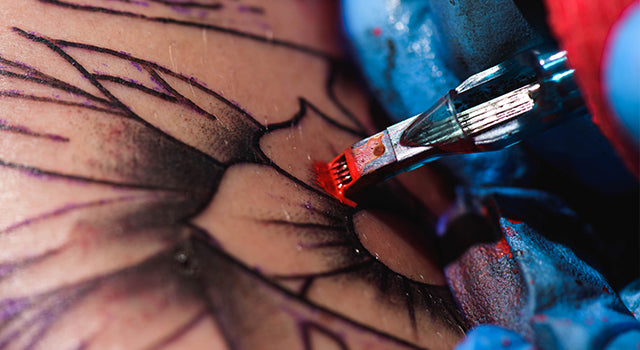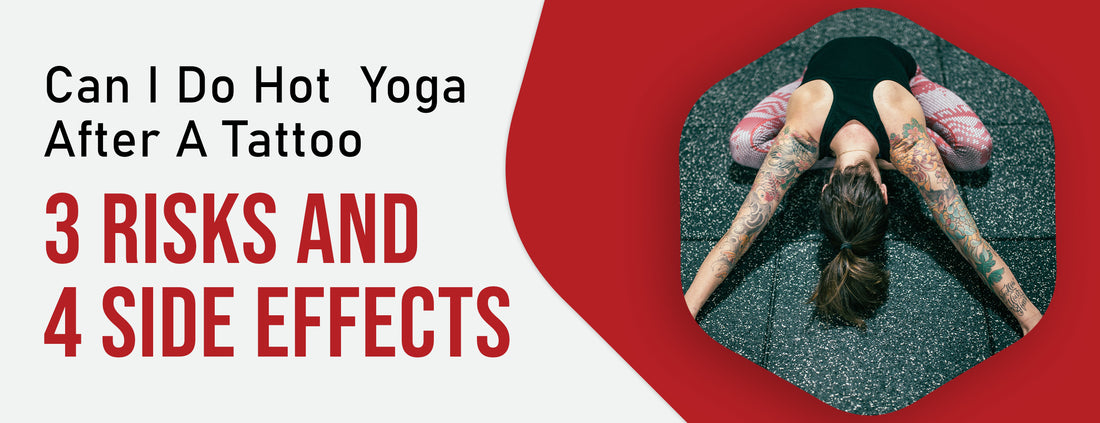The heat from hot yoga can cause irritation and damage to the new tattoo, increasing the risk of tattoo fading, infection, and redness around the tattooed area. It's necessary to understand the risks before diving back into your routine.
No. To ensure proper healing, avoiding exposing a new tattoo and excessive sweating for at least 2 weeks is needed. Tattoos are open wounds, So hot yoga or strenuous physical activities should also be avoided during this time, as they can delay healing.
In this blog post, we'll explore the risks and side effects of doing hot yoga after a tattoo and expert advice on how long to wait, what to avoid, and alternative options.
Can I Do Hot Yoga After A Tattoo: 3 Risks And 4 Side Effects

When you get a tattoo, your skin undergoes a significant process. The tattoo needle punctures your skin, depositing ink in the dermis, where our sweat glands and hair follicles are located. This process is a controlled skin injury and requires proper care and caution.
Risks of Hot Yoga After Tattoos
To ensure a successful healing process after a tattoo, proper aftercare is essential. Hot yoga should not be practiced right after getting a tattoo, though it can be an exciting experience. After getting a tattoo, doing hot yoga carries the following risks:
Excessive Sweating
Hot yoga is known for its high temperatures and intense workouts, which cause you to sweat profusely. Excessive sweating is a risk factor for tattoos. The pigment in your tattoo can be lost through sweating. This can cause faded colors, blotchiness, and uneven lines. It not only affects the appearance of the tattoo, but it can also increase infection risks.
Here are some things to remember when considering hot yoga after a tattoo:
- Wait 48 hours before engaging in any activity that causes excessive sweating, including hot yoga.
- Always wear loose, comfortable clothes that allow your skin to breathe and prevent friction against the tattoo.
- Use a towel to remove excess sweat during practice and avoid rubbing the tattoo directly.
- Use mild, fragrance-free soap and lukewarm water to clean the tattoo gently after hot yoga. Be sure to pat the area dry with a clean, soft towel.

Heat Exposure
hot yoga can also harm a tattoo's healing process because of excessive sweating. Increased heat can cause blood vessels to dilate, leading to heightened circulation to the skin and a potential increase in the risk of bleeding, bruising, and scarring. During heat, the tattoo can become dry, flaky, and itchy, creating the temptation to scratch, resulting in damage.
Here are some tips for minimizing the risks of heat exposure after getting a tattoo while performing hot yoga:
- After getting a tattoo, wait at least one week before participating in hot yoga.
- You should avoid direct contact with heated surfaces, such as mats and towels, which could cause irritation or damage to your tattoo.
- Make sure you stay hydrated before, during, and after your yoga practice to avoid dehydration and heatstroke.
Physical Contact
Physical contact is another risk factor during hot yoga and can be dangerous for a new tattoo.Yoga mats, towels, and other equipment harbor bacteria and germs. These can quickly enter the skin, leading to infections and other complications. The pressure on the tattoo while doing yoga poses can cause irritation, swelling, and bruising.
Here are some suggestions for minimizing physical contact in hot yoga after getting tattooed:
- Please inform your instructor before class that you recently got a tattoo and request that minimal adjustments be made.
- Avoid positions that require excessive physical contact or contact with tattooed body areas.
- To prevent infection, the instructor should wear gloves or use a clean, sterile surface.
The Side Effects of Hot Yoga After Getting Tattooed
Hot yoga involves practicing yoga in high temperatures, usually above 100°F. Heat can cause excessive sweating and make even the fittest sweat excessively. If you recently got a tattoo, pause before entering a hot yoga studio. Hot yoga can cause inflammation, delayed healing, and infection after getting a tattoo.
Inflammation

Yoga can cause inflammation in your body, which can cause complications if combined with an already inflamed tattoo area. Tattoo needles puncture your skin hundreds of times, causing trauma to the area.
The body's natural response to trauma is inflammation, which protects the wound from further damage. Extreme heat can exacerbate the inflammation, causing pain and discomfort.
Fading
When you get a new tattoo, it's important to protect it from fading. Hot yoga can cause your tattoo to fade quickly, affecting its appearance.
Delayed Healing
Tattoos require proper healing time to ensure they turn out as expected. The healing time depends on the location and size of the tattoo. It takes 7-14 days for tattoos to heal completely. It is essential to take good care of the tattoo during this time, such as avoiding soaking it in water and wearing tight clothing that can rub against it. Yoga can interfere with the healing process, resulting in delays or other complications, such as scarring.
Infection
Yoga studios can be humid, and the heat can increase your risk of infection. Bacteria can grow in excessive sweat, resulting in skin infections. You are at even greater risk if you have an open wound from a recent tattoo. Medical attention may be required if infections cause severe complications.
Expert Opinions
Most tattoo artists and healthcare professionals advise against doing hot yoga or any strenuous physical activity immediately after getting a tattoo. The consensus is to let your skin heal appropriately before resuming such activities.
Remember, it’s crucial to prioritize the health of your skin and the longevity of your tattoo over your desire to return to hot yoga. In case of concerns or questions, consult a healthcare professional.

Doing Hot Yoga After Getting A Tattoo: Timeline & Tips
If you're a hot yoga fan who just got a tattoo, you might wonder when it's safe to return to the studio. While sweating it out in a 105-degree room sounds exciting, you must prioritize your skin's healing process to avoid complications. If you've got a tattoo, here's what you need to know about hot yoga.
Ideal Waiting Period
When you get a tattoo, wait 2 weeks before you resume hot yoga or any other physical activity involving sweating or friction. The tattoo will heal in the first 24 hours after getting inked and form a protective scab. Exposing it to heat and moisture (such as in a hot yoga class) increases the risk of infection, scarring, and color fading. Hot yoga can cause your skin to stretch and pull, affecting your tattoo's quality and longevity.
Follow your tattoo artist's aftercare instructions after the first 24 hours, including washing the area with mild soap, drying it, avoiding direct sunlight, and refraining from scratching or picking at the scab. If you are experiencing any signs of infection (such as redness, swelling, oozing, or fever) or are unsure whether hot yoga is safe for you, consult your tattoo artist.
Tips for slowly reintegrating hot yoga into your routine
Once the 2-week mark has passed, you may be eager to return to your hot yoga routine. It is essential to start slowly and listen to your body's signals. Here are some tips for safely reintegrating hot yoga into your practice:
- Find a gentle, beginner-friendly class emphasizing proper alignment, breathing, and relaxation. Advanced or intense classes that involve inversions, arm balances, and fast-paced sequences may strain your joints and muscles.
- Before, during, and after the class, stay hydrated. Ensure you bring a water bottle and take breaks whenever necessary.
- Wear comfortable, breathable clothing that allows your skin to breathe. Avoid tight, restrictive, or synthetic fabrics that can cause irritation or chafing.
- Bring a towel and wipe off any sweat or moisture accumulating on your skin or yoga mat. This can help prevent bacterial growth and maintain hygiene.
- Keep your tattoo clean and dry. Clean your tattoo thoroughly after each yoga session, avoiding excessive sweat.
- Observe any discomfort, pain, or sensitivity in the tattooed area. Any pose that causes discomfort or strain should be stopped or changed. If you need adjustments or modifications, let your instructor know.
- After class, wash your skin with cold water (avoid hot water). Your muscles will be soothed, and your circulation will be improved.
Getting A Tattoo And Doing Hot Yoga: What to Avoid & Alternative

Many people are skeptical about hot yoga and tattoos. There are specific and don'ts that you need to follow to ensure your tattoo's long-term health and longevity. Apart from hot yoga, there are other activities that you should avoid after getting a tattoo. These include.
- Excessive Sun Exposure: Direct exposure to the sun will fade, discolor, and destroy your tattoo. It is recommended in the first month after getting a new tattoo.
- Scratching and Picking: Itchy skin is a common side effect of healing tattoos. However, scratching or picking at your tattoo can cause scarring, infection, and damage to your new tattoo. It is essential to resist the temptation to cross or pick at your tattoo and use a mild, fragrance-free moisturizer to relieve the itching.

Some Alternative Exercises to Hot Yoga After Tattooing
While your tattoo heals, you can do plenty of activities instead of hot yoga. Let's explore alternative practices to break a sweat without harming your new tattoo in this article about tattoos and hot yoga.
- Gentle Yoga.
- Walking or jogging.
- Cycling or spinning.
- Pilates or barre classes.
- Low-intensity yoga or stretching.
Conclusion
After getting a tattoo, hot yoga can be dangerous and cause unwanted side effects such as infection, inflammation, or fading. You can optimize your tattoo's healing process by avoiding hot yoga for at least 2 weeks and following your tattoo artist's aftercare instructions.
You can explore alternative exercise options during this time that won't interfere with your tattoo's healing. When you resume hot yoga, be sure to listen to your body and start slowly. Consult a physician as soon as possible if you experience discomfort or pain.









![Antibiotics and Tattoos: 3 Risks and 3 Effects [with 4 Precautions]](http://drnumb.com/cdn/shop/articles/Can_You_Get_Tattooed_On_Antibiotics__3_Risks_and_3_Effects_4_Precautions.jpg?v=1714128292)

